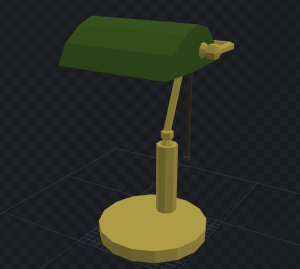In level 1, the player is introduced to their first patient and is asked to remove the doll’s eyes, replace them with new ones, and repaint the damaged makeup. The dolls were going to be a major part of the game so I spent the first few weeks working on how I was going to make them and what they should end up looking like. We knew from the design phase that we wanted a mixture of 2D and 3D assets, so I incorporated both mediums into the doll.
I was going to have to make multiple dolls, so I thought it would make my life easier if I had a template to work off of, that I could pose however I liked, to help me make all the dolls I would need. I thought the best way to do this was by making a 3D model I could draw over and add 2D details to. I decided to use the program Blockbench because it was free, easy to learn, and focused on crafting very low poly models which meant I could get my doll parts done faster and move on to other aspects of the project.



I have experience using Google Sketchup from my high school architecture lessons and in many ways Blockbench was similar. There is a focus on extruding and manipulating existing shapes into your desired model, rather than building something from scratch. There’s much less you can do so you have to think outside the box for some things, especially with rounded shapes. Blockbench is mostly used for making mods for the game Minecraft, which is decidedly not round.
I practised the program before we formally started making the game, by making one of the lamps that’s in my bedroom. The lamp was a great jumping-off point because it had rounded sections (like the glass shade and the bulb) as well as polygonal sections like the frame. It was also just pretty handy that we could end up using it on the Doctors table in level 1 because it fit the Victorian aesthetic.


Sam Bedson
